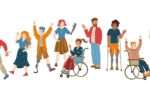We Don’t Wear Uniforms; Interpreters Dressing for Success
By Ousia Whitaker-DeVault
Here at SWITS we have some freedom to decide what to wear while interpreting. It is up to us, with guidance from the SWITS dress code, to make choices that allow us to provide the best language services possible with clothing and accessories that do not distract or offend others, or impede us physically. This means presenting ourselves in a practical and unobtrusive manner. Personal presentation includes not only clothing choice, but also hygiene, aroma, sound, color, and pattern.
Depending on the setting, expectations for attire may vary widely. Some of our customers have more explicit or strict rules for employees, so keep in mind the norms at different locations and, when in doubt, air on the more conservative side. In a surgical setting, it in unacceptable to wear open-toed shoes, and perfume is not permitted in allergy clinics and many other medical venues. If you are working with low-income families, or visiting people in their home, use good judgement in choosing attire that is not flashy or fancy.
If you will be going outside, plan for appropriate footwear and layers (especially in cold weather). Some of the best prepared interpreters keep a change of clothes in their car in case of spills or last-minute assignments. In the winter, it is a good idea to have blankets and emergency supplies as well.
To avoid distractions during an assignment, aim to keep your work attire simple and, when in doubt, default to black, gray, or dark blue. Dark tones and minimal patterns help to project a professional and unobtrusive presence. Wear shirts without logos or graphics, and pants that stay up consistently. Avoid distracting accessories or jewelry that make noise when you move, or which may pose a safety risk.
When planning what you will wear for your next interpreting assignment, prioritize safety and tidiness. Always adhere to SWITS dress-code (detailed in full in the employee manual), and consider the specific requirements and norms for the places in which you interpret. Professionalism is a culturally specific value, so we must use intercultural understanding to predict what kinds of hairstyles, shoes, postures and gestures will be considered professional to those we work with.
Professional dress codes may seem limiting or unrealistic for some, because of the fact that societal expectations for professionalism exist for a normative employee, who is often gendered, raced, classed, and body-sized. While interpreting, you should feel comfortable and confident about the way in which you present yourself, regardless of identity or body type.
If you have questions about how to make the SWITS employee dress code work for you, please consult the employee manual, email me at interpretercoach@swits.us, or contact our HR department.







